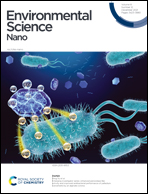Converting mesoporous polydopamine coated MIL-125 (Ti) to a core–shell heterostructure for efficient water desalination†
Abstract
Integrating pseudocapacitive materials with a conductive carbonaceous matrix is an efficient method to improve their capacitive deionization (CDI) performance. However, it remains a challenge to optimize the structure and chemical component of each part and strengthen the internal bonding between them for the further improvement of salt adsorption capacity (SAC). Herein, we report an ultrafine anatase TiO2/carbon nanocomposite confined into N-doped mesoporous carbon (TiO2/C@NMC) via a mesostructured polydopamine (mPDA) coated MOF strategy and subsequent pyrolysis. During the pyrolysis process, the mPDA shell could construct a spatially confined environment to effectively limit the aggregation of TiO2 nanoparticles and restrain their transformation into the rutile phase, contributing to the abundant faradaic active sites and strong interaction with a conductive carbon matrix. Moreover, the mPDA shell-derived N-doped mesoporous carbon provides abundant ion diffusion channels and alleviates the volume variation of the inner faradaic materials during the adsorption/desorption process. As a result, TiO2/C@NMC delivers an excellent SAC of 27.73 mg g−1 and stable regeneration properties over 50 cycles, demonstrating its great potential as a superior pseudocapacitive electrode for hybrid CDI (HCDI). This work offers a promising strategy to regulate the properties of pseudocapacitive materials for designing advanced HCDI devices.



 Please wait while we load your content...
Please wait while we load your content...